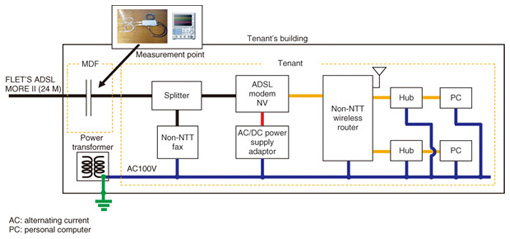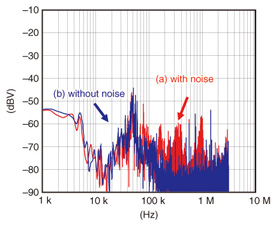 |
|||
|
|
|||
|
Practical Field Information about Telecommunication Technologies Vol. 11, No. 6, pp. 22–26, June 2013. https://doi.org/10.53829/ntr201306pf1 A Study of a Noise Measurement Method for Efficient and Smooth TroubleshootingAbstractThis article describes a study carried out on a noise measurement method in telecommunication lines to make fault troubleshooting more efficient and smooth. This is the seventeenth in a bimonthly series on the theme of practical field information on telecommunication technologies. This month's contribution is from the EMC Engineering Group, Technical Assistance and Support Center, Maintenance and Service Operations Department, Network Business Headquarters, NTT EAST. 1. IntroductionMeasures for saving energy in electrical and electronic equipment have become more sophisticated in recent years. Such measures include the adoption of energy-saving inverter circuits in the power-supply parts of equipment. The energy-saving performance of such circuits is high, but the level of radio interference can also be high if no anti-noise measures are taken. Noise can also be generated as a result of faults or insufficient insulation in the power-supply part. Such noise can penetrate telecommunications equipment in a user’s building or home via a power-supply line or space and can cause malfunctions in asymmetric digital subscriber line (ADSL) or very-high-speed DSL (VDSL) modems or in the generation of audible noise. Measuring the voltages between a telecommunication line and earth (VL1-E or VL2-E) in telecommunication lines when inspecting telecommunication equipment for noise-related faults is one of the most important means of troubleshooting the causes of such faults. However, this method unfortunately results in the measurement of noise components not in isolation, but as components of telecommunication signals. As a result, there are times when the noise cannot be clearly identified, which makes it all the more difficult to troubleshoot the causes of noise. We propose a simple method for separating the external noise and the signals and have developed a separation probe as a prototype product incorporating this method. We describe the results of tests that were conducted in our laboratory and in the real field to evaluate the effectiveness of the noise-separation method and the separation probe in troubleshooting noise-related faults. 2. BackgroundThe measurement of common mode noise in telecommunication lines when troubleshooting noise faults is shown in Fig. 1. This method measures voltage between the telecommunication line and a ground (VL1-E or VL2-E). When the telecommunication line is not in a communication state, the common mode voltage is equivalent to voltage caused by noise. An example of the results of measuring common mode noise is shown in Fig. 2. In this case, only the noise waveform was measured, which made it relatively easy to check for noise. Next, the common mode noise was measured when noise was superposed on an ADSL/VDSL line when the line was in a communication state (Fig. 3). In this case, a signal is continuously applied on the telecommunication lines so that the measured common mode voltage corresponds to the signal + noise. An example of the results of measuring common mode noise associated with a dropped link in the ADSL service is shown in Fig. 4. The measured waveform shows that noise is superposed on the signal, which makes it difficult to check for the presence of the noise and adds to the time required for fault troubleshooting. A device such as a separation probe was therefore needed that could make fault troubleshooting more efficient by separating and extracting the fault-causing noise from the signals.
3. Separation of noise and signalsThe conventional method of measuring common mode noise (VL1-E or VL2-E) involves measuring voltage when the noise and the signal are superposed, as described above. In order to separate the noise, we use the results of two measurements: the common mode voltage between L1 and E and that between L2 and E. It is known that noise can be approximately determined by Eq. (1) according to the definition of common mode voltage [1]. At the same time, the signal can be approximately determined by Eq. (2). 4. Separation probe and test results4.1 Overview of separation probeOur prototype separation probe achieves the functions expressed by Eqs. (1) and (2). The configuration of the probe is shown in Fig. 5, and an external view of the probe is shown in Fig. 6. The separation probe consists of input parts, an adder and subtractor, output parts, and a power supply. In common mode measurement, the L1-E and L2-E voltages are measured by using a high-impedance probe connected to each of the input parts. The results of these measurements are processed in an analog manner by additive (Vnoise) and subtractive (Vsignal) processing and then output to an oscilloscope. The power supply can be fed to the probe’s main unit by either an internal battery or an external power supply from the oscilloscope.
4.2 Results of laboratory testIn order to test the separation probe, we applied an external 160-kHz sinusoidal wave as common mode noise to the signals of an ADSL line. The measurement results using the separation probe are shown in Fig. 7. The upper half of the figure shows the noise voltage waveform and the lower half the signal voltage waveform. These results show that the 160-kHz sinusoidal wave applied as the noise was able to be extracted, which made it possible to observe the signal waveform with the noise component separated from it. In other words, the results of this test demonstrated that the separation probe functioned effectively. For reference, the VL1-E and VL2-E voltage waveforms measured by the conventional technique are shown in Fig. 8. These results show that it is difficult to confirm the existence of a 160-kHz sinusoidal wave applied as noise from conventionally measured waveforms.
4.3 Results of field testWe also examined the effectiveness of applying our separation probe for troubleshooting in the case of a dropped link in ADSL services. In the following, we introduce one of three tests that we performed in the field. (1) Fault description Dropped links in the ADSL line in a tenant building frequently occurred between 9:00–10:00 AM. (2) Facilities overview and noise measurement An overview of the actual facilities in the field is shown in Fig. 9. The ADSL line was connected to the tenant’s ADSL modem via a main distributing frame (MDF). The noise voltage on the signal line was measured at the MDF using the separation probe.
(3) Measurement results The noise waveform at the time the ADSL signal is lost is shown in Fig. 10. The upper half of the figure shows the noise waveform and the bottom half the signal waveform. An examination of the noise waveform on top shows that the measurement of noise was unaffected by the signal.
The frequency spectrum obtained by subjecting this noise waveform to fast Fourier transform (FFT) analysis is shown in Fig. 11. When the waveforms of Fig. 11(a) (with noise) and Fig. 11(b) (without noise) are compared, it can be seen that the noise level is high in the frequency band of 80 kHz–1 MHz. The noise was found to fall within the frequency band used for ADSL signals (28 kHz–3.75 MHz). This particular test case therefore clarified that the superposing of the noise on the signal resulted in a dropped link of the ADSL line. Additionally, we found that the separation probe used in this test and other tests was effective for quickly checking for noise and reducing the time required to troubleshoot faults. In this test case, moreover, the signal voltage level was 9 Vp-p, which was much higher than the noise voltage level of 1 Vp-p. This suggests that use of the conventional method would make it difficult to check for the presence of noise at such a low level and would require more time to troubleshoot the cause of the fault.
5. ConclusionWe developed a probe for separating noise from a telecommunication signal and tested it in both the laboratory and the field using ADSL lines. Test results showed that the separation probe was effective in extracting the noise component even if the noise level was lower than that of the signal. In the future, we plan to conduct more evaluations in the field to improve the accuracy of the probe and to study the feasibility of commercializing it. We are committed to developing methods for quickly solving noise faults and will continue to carry out work that supports the provision of safe and secure telecommunication services. Reference
|
|||



















